Review-create1 Failed to Load Resource the Server Responded With a Status of 404 (Not Found)
When it comes to developing WordPress in a local surround, XAMPP is a pop and trusted tool. However, that doesn't mean yous won't e'er run across errors. One you might come beyond is the HTTP mistake 404 "The requested resource is not plant."
If you lot encounter this upshot, there are several ways to effort to resolve it. These fixes aren't overly complicated and don't take a lot of time to perform. With a footling patience, you should exist back up and running in no time. In this article, we'll explicate what the fault "requested resource is not institute" in XAMPP is. And so, nosotros'll share v tips for how to prepare the problem and get yous back on rails.
What the XAMPP HTTP Fault 404 "The Requested Resources Is Not Institute" Means
A 404 error is 1 of many HTTP status codes that are sent from a server to a client. In full general, this mistake indicates that the browser is requesting something that can't be found on the server.

Information technology can be challenging to determine the source of a 404 error, as there are several potential causes. These can include:
- The domain no longer exists.
- The requested resource has been deleted or moved to a different URL.
- The URL was mistyped into the browser.
You've likely meet these situations when browsing the web. However, you tin can encounter 404 errors when working on localhost with XAMPP as well. In this instance, you may besides see the message expressed as Error 404 "the object is not plant."
How to Fix the HTTP Error 404 "The Requested Resource Is Not Found" in XAMPP (5 Tips)
Now that you sympathize what this particular XAMPP mistake is, let'southward explore how to fix it using the post-obit five tips.
1. Exist Sure Yous Typed the URL Correctly
Before yous effort whatsoever other fixes, we recommend double-checking that y'all oasis't mistyped or included anything unnecessary in the URL. For instance, a common fault is including "XAMPP" when information technology'south not needed:

Errant keystrokes are a frequent cause of this error but are also easy to prepare. If you're sure you've entered the right URL and are still having bug, there are a few other solutions you can endeavour.
2. Bank check Your .htaccess File
A missing .htaccess file can also cause a 404 error. Therefore, information technology'due south of import to be sure the file exists in the correct location, especially if you come across the "the object is not plant" version of the error.
To find the file, you can navigate to the XAMPP binder on your computer. Inside this binder, in that location volition exist another ane called htdocs. This folder is likely where you installed WordPress when y'all initially prepare your website. You lot should find the .htaccess file at that place:
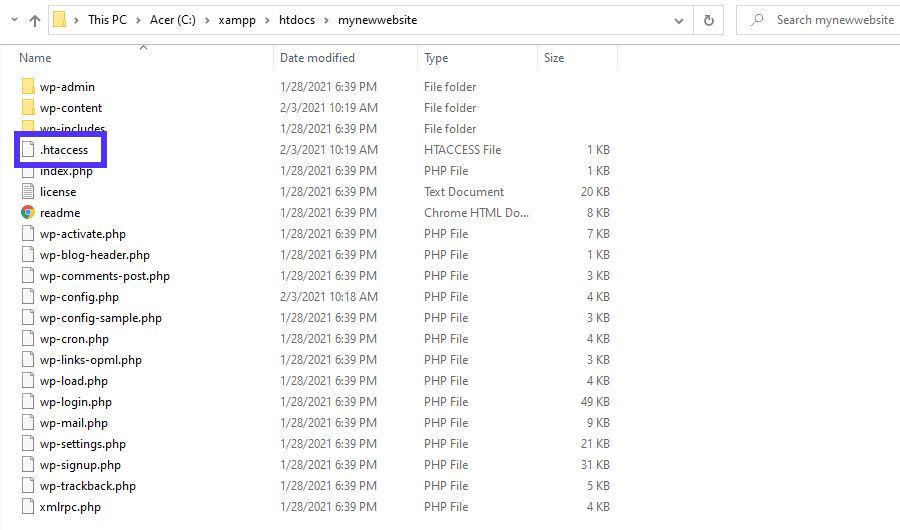
If you are using a macOS, the file will nevertheless be in the htdocs folder. However, you'll find it via Applications > Xampp > xamppfiles > htdocs.
If the file doesn't exist, you'll demand to create 1. To practice this, open up your preferred text editor and name the file ".htaccess". The exact code you lot demand to paste into it may vary depending on your setup, but it should look something like this:
# BEGIN WordPress RewriteEngine On RewriteRule .* - [Eastward=HTTP_AUTHORIZATION:%{HTTP:Authorization}] RewriteBase / RewriteRule ^index.php$ - [L] RewriteCond %{REQUEST_FILENAME} !-f RewriteCond %{REQUEST_FILENAME} !-d RewriteRule . /index.php [L] # Stop WordPress Save the file to the binder you created for your website. Even if you don't discover an obvious trouble with your .htaccess file, sometimes simply replacing it with a fresh 1 can fix the mistake.
3. Deactivate and Uninstall New Plugins
When you lot install plugins, they may brand changes to your code or database that can crusade this 404 error. Starting with your newer plugins, yous tin can try deactivating or uninstalling them to run across if that fixes the problem.
Plugins tin can be deactivated from the admin dashboard of your local site. To do so, in the menu on the left of the screen, click on Plugins > Installed Plugins. To deactivate one, click on the Deactivate link under the name of the plugin:
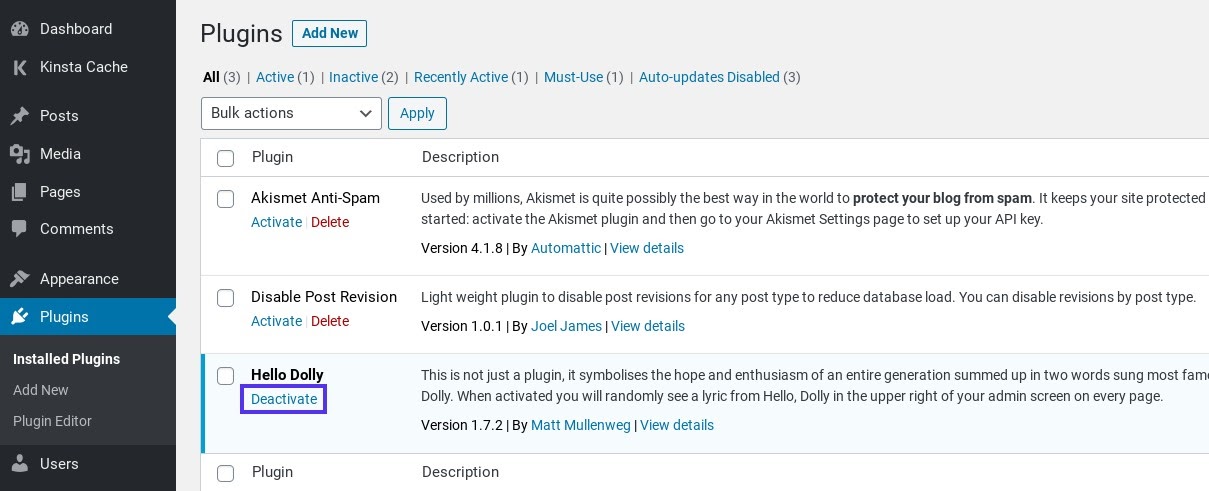
If you lot want to uninstall a plugin completely, you lot can exercise so from the same screen. First, deactivate the plugin, then click on the red Delete link that below the name of the plugin:
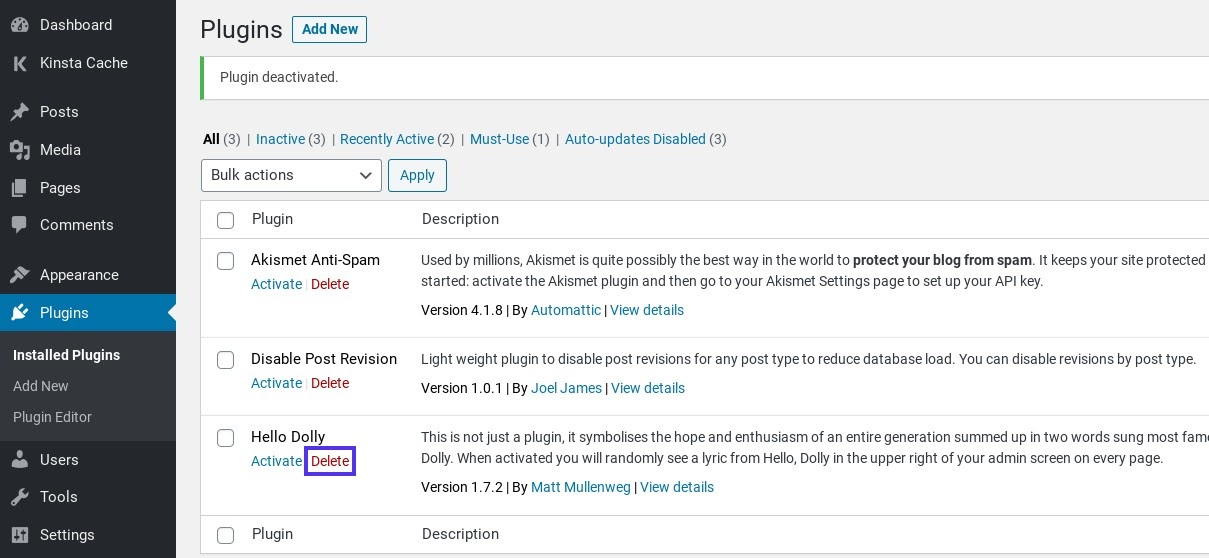
Even if you haven't installed any plugins recently, this is worth trying, since updates to plugins tin can sometimes cause issues. Y'all can also deactivate all of your plugins at one time by renaming the plugins folder in your site's directory.
Subscribe Now
four. Check Your Database for Changes
Even if you uninstall a problematic plugin, the changes it made to your site may continue to crusade issues. If you doubtable this is the case, you may desire to bank check your local site's database for changes.
To access the database, you can type http://localhost/phpmyadmin into your browser. Alternatively, from the XAMPP command console, y'all can click on the Admin button next to MySQL to open phpMyAdmin.

Now you can click on the Databases tab at the top of the screen. Locate your website's database in the list to view the tables information technology contains:
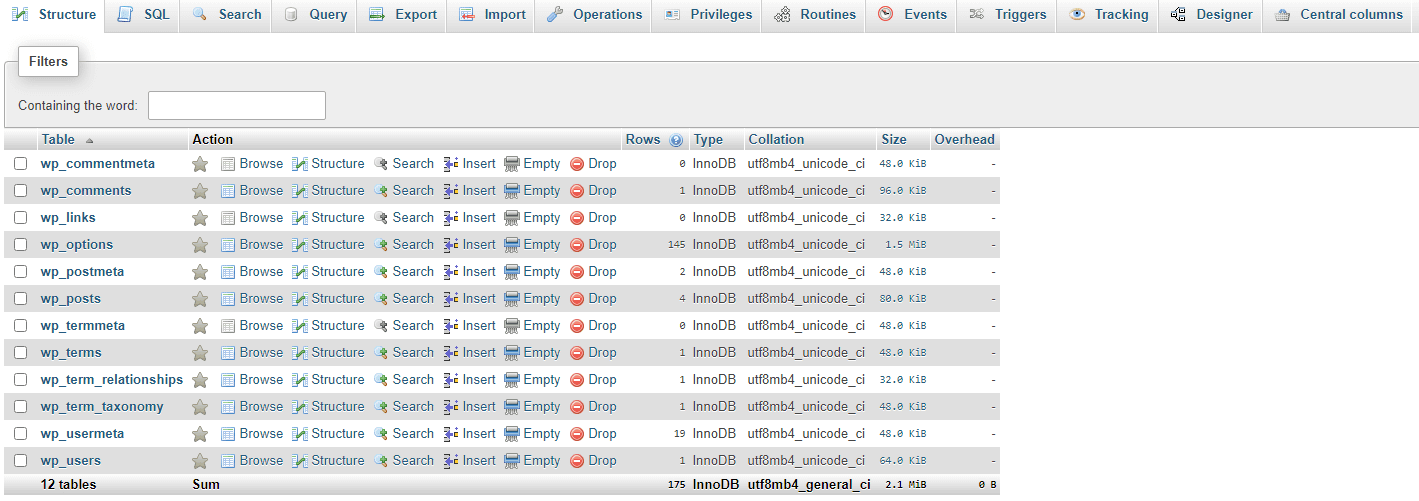
Next, you'll want to comb through the database and look for anything that shouldn't be in that location. Some plugins will add entirely new tables to your database. To remove an unnecessary table, click on the Drib link to its right:

Most plugins will make changes to the wp_options table, then you lot'll desire to take a look at that entry. You lot can also check the core WordPress tables. While plugins shouldn't alter these tables, it is possible, especially if you installed a nulled plugin.
If you're unsure what your database or tables are supposed to await similar, you lot may want to create a new WordPress site. Then you lot tin compare the fresh database to yours.
5. Check Your Apache Configuration
If you're having problem opening a PHP file, your Apache configuration could exist incorrect. More specifically, there may be a conflict with the port that Apache is trying to use.
Apache uses port 80 past default, but you may need to change information technology if you already accept something listening on that port. To detect a free port, you can click on the Netstat push button in the XAMPP control panel:

If port eighty is already in utilize, or if you just prefer to leave it open, you can go ahead and choose a gratis port number. We'll use "8080" for this example, but you can employ whichever port you'd similar.
Adjacent, yous'll need to edit the httpd.conf file. You can find it in C:\xampp\apache\config if you're using Windows:

If you're working on macOS, you lot can find this file in the /etc/apache2 directory. You lot can locate information technology using the Go to Folder option in Finder.
In one case you've found the file, become ahead and open it in your preferred text editor. There are two lines you lot'll need to edit:
Listen lxxx ServerName localhost:eighty Change the Listen port number to 8080 and the ServerName to localhost:8080. Now you can save and shut the file.
At this bespeak, yous can restart the Apache server and attempt to access localhost:8080 (or whichever port y'all're using) in your browser. If you're not successful, you lot'll need to edit the http-ssl.conf file. Windows users can discover this file in xampp\ apache\ conf\ actress.
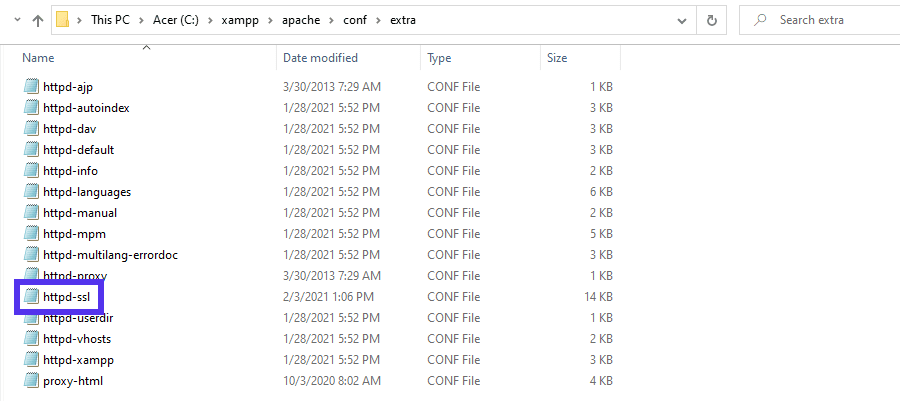
Once over again, y'all should be able to locate this file on a macOS by typing /etc/apache2 into Finder'due south Go to Binder.
Once located, you can open the file in a text editor. There are three lines that you'll demand to update in this file:
Listen 443 <VirtualHost _default_:443> ServerName localhost:443 Locate each of these lines in the file and change the values to "8080". Afterwards saving the file, you can restart the Apache server again. Now you should be able to access localhost:8080 in your browser.
Summary
The "requested resource is non constitute" error tin undoubtedly slow y'all downward when you're working with XAMPP. There are a few possible causes for this issue. Fortunately, the solutions for resolving information technology aren't complicated.
In this post, we covered a few means you tin can effort to fix the XAMPP Error 404. You tin start by ensuring that you've entered the URL correctly, and move on from at that place. With whatsoever luck, you'll be dorsum to work in no time.
If you enjoyed this tutorial, then you'll love our support. All Kinsta's hosting plans include 24/vii support from our veteran WordPress developers and engineers. Cheque out our plans today to larn more!
Salvage time, costs and maximize site functioning with:
- Instant help from WordPress hosting experts, 24/7.
- Cloudflare Enterprise integration.
- Global audience reach with 29 data centers worldwide.
- Optimization with our built-in Application Functioning Monitoring.
All of that and much more, in one plan with no long-term contracts, assisted migrations, and a thirty-solar day-money-back-guarantee. Check out our plans or talk to sales to discover the plan that'due south right for you.
Source: https://kinsta.com/knowledgebase/xampp-http-error-404-the-requested-resource-is-not-found/
0 Response to "Review-create1 Failed to Load Resource the Server Responded With a Status of 404 (Not Found)"
Postar um comentário